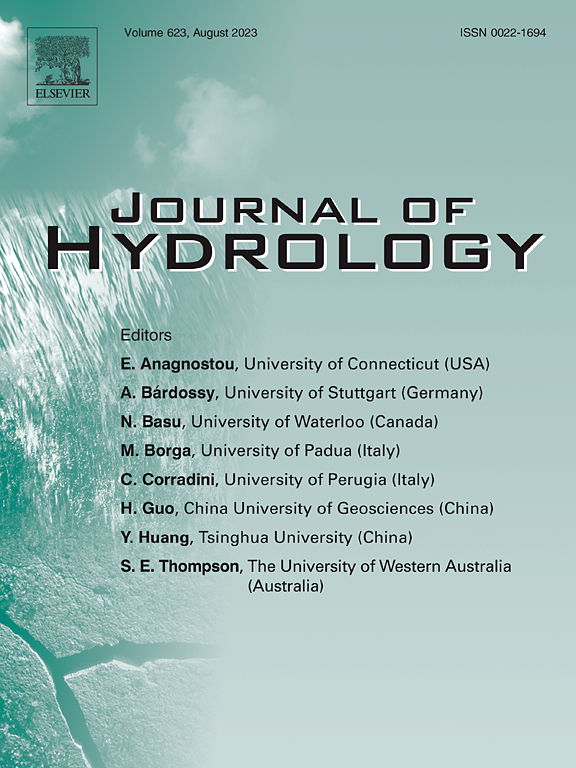Contrasting influences of diurnal patterns and rainfall events on riverine CO2 degassing: insights from in situ high-resolution monitoring
IF 6.3
1区 地球科学
Q1 ENGINEERING, CIVIL
引用次数: 0
Abstract
High-resolution measurements of CO2 flux are critical for accurate estimation of CO2 degassing in inland waters. However, persistent challenges remain due to limited high-frequency datasets and incomplete understanding of diurnal CO2 dynamics and rainfall influences. This study implemented 35 days high-resolution monitoring campaign targeting hydrological, hydrogeochemical, and atmospheric parameters across three transects of the Lijiang River (LJR), a representative karst river in southwestern China, during the monsoon season. Key findings demonstrate that: (1) The LJR consistently functioned as a CO2 source. Neglecting diurnal pCO2air variability introduced systematic biases, causing daytime flux underestimation (136.9 mg·m−2·h−1) and nighttime overestimation (72.6 mg·m−2·h−1). Site-specific continuous pCO2air monitoring reduced these errors by 18–32 % compared to fixed atmospheric defaults; (2) Flood events amplified CO2 emissions by 200–300 %, primarily driven by turbulence-enhanced gas transfer velocity (, contributing 91.0–94.6 % to evasion). In contrast, non-flood periods were governed by metabolic pCO2water signals (71.0–86.9 % flux contribution). This mechanistic shift necessitates phase-specific sampling strategies; (3) Excluding flood events caused 34.1–45 % flux underestimation in this karst basin, exceeding parametric uncertainties (V, S, pCO2water and pCO2air) by 2.2–4.5 times. DIC-enriched floods delivered > 62 % of annual CO2 evasion, aligning with global observations of 25–45 % tropical flux underestimation from flood neglect; (4) Monitoring ≥ 3 flood events per hydrological year and at the same time extend the monitoring to the transition before and after the flood, quantifying that carbonate weathering pulses dominate the annual escape can reduce flux deviation by 60–70 %. Combining dynamic pCO2water and pCO2air measurements with specific stage models can reduce the uncertainty of global river fluxes by 30–50 %, especially in carbonate-rich catchments. Conventional approaches risk overestimating CO2 degassing through neglect of diurnal variability during stable hydrologic conditions while underestimating fluxes by disregarding rainfall impacts. These results underscore the necessity of high-frequency monitoring protocols to refine greenhouse gas (GHG) flux quantifications in fluvial systems.

日模式和降雨事件对河流CO2脱气的对比影响:来自原位高分辨率监测的见解
二氧化碳通量的高分辨率测量对于准确估计内陆水域的二氧化碳脱气至关重要。然而,由于有限的高频数据集和对二氧化碳日动态和降雨影响的不完全了解,持续的挑战仍然存在。本研究在季风季节对中国西南代表性喀斯特河流丽江(LJR)的三个样带进行了为期35天的水文、水文地球化学和大气参数高分辨率监测。主要研究结果表明:(1)LJR持续发挥CO2源的作用。忽略pCO2air的日变化会引入系统偏差,导致白天通量低估(136.9 mg·m−2·h−1)和夜间通量高估(72.6 mg·m−2·h−1)。与固定的大气默认值相比,特定地点的连续pCO2air监测将这些错误减少了18 - 32%;(2)洪水事件使CO2排放增加200 ~ 300%,主要由湍流增强的气体传递速度(kCO2)驱动,对逃避贡献91.0 ~ 94.6%。相比之下,非洪水期受代谢pco2水信号(71.0 - 86.9%通量贡献)控制。这种机制转变需要相位特定的采样策略;(3)排除洪水事件导致该岩溶盆地的通量低估34.1% ~ 45%,超过参数不确定性(V、S、pCO2water和pCO2air) 2.2 ~ 4.5倍。富含碳水化合物的洪水带来了>;62%的年二氧化碳逃避量,这与全球观测数据一致,即由于忽视洪水而低估了25 - 45%的热带通量;(4)每个水文年监测≥3次洪涝事件,同时将监测范围扩大到洪涝前后的过渡时期,量化碳酸盐风化脉冲主导年逃逸,可使通量偏差降低60 - 70%。将动态pCO2water和pCO2air测量与特定阶段模型相结合,可以将全球河流通量的不确定性降低30 - 50%,特别是在富含碳酸盐的集水区。传统方法由于忽视稳定水文条件下的日变率而存在高估二氧化碳脱气的风险,同时由于忽视降雨影响而低估了通量。这些结果强调了高频监测方案的必要性,以改进河流系统的温室气体(GHG)通量量化。
本文章由计算机程序翻译,如有差异,请以英文原文为准。
求助全文
约1分钟内获得全文
求助全文
来源期刊

Journal of Hydrology
地学-地球科学综合
CiteScore
11.00
自引率
12.50%
发文量
1309
审稿时长
7.5 months
期刊介绍:
The Journal of Hydrology publishes original research papers and comprehensive reviews in all the subfields of the hydrological sciences including water based management and policy issues that impact on economics and society. These comprise, but are not limited to the physical, chemical, biogeochemical, stochastic and systems aspects of surface and groundwater hydrology, hydrometeorology and hydrogeology. Relevant topics incorporating the insights and methodologies of disciplines such as climatology, water resource systems, hydraulics, agrohydrology, geomorphology, soil science, instrumentation and remote sensing, civil and environmental engineering are included. Social science perspectives on hydrological problems such as resource and ecological economics, environmental sociology, psychology and behavioural science, management and policy analysis are also invited. Multi-and interdisciplinary analyses of hydrological problems are within scope. The science published in the Journal of Hydrology is relevant to catchment scales rather than exclusively to a local scale or site.
 求助内容:
求助内容: 应助结果提醒方式:
应助结果提醒方式:


